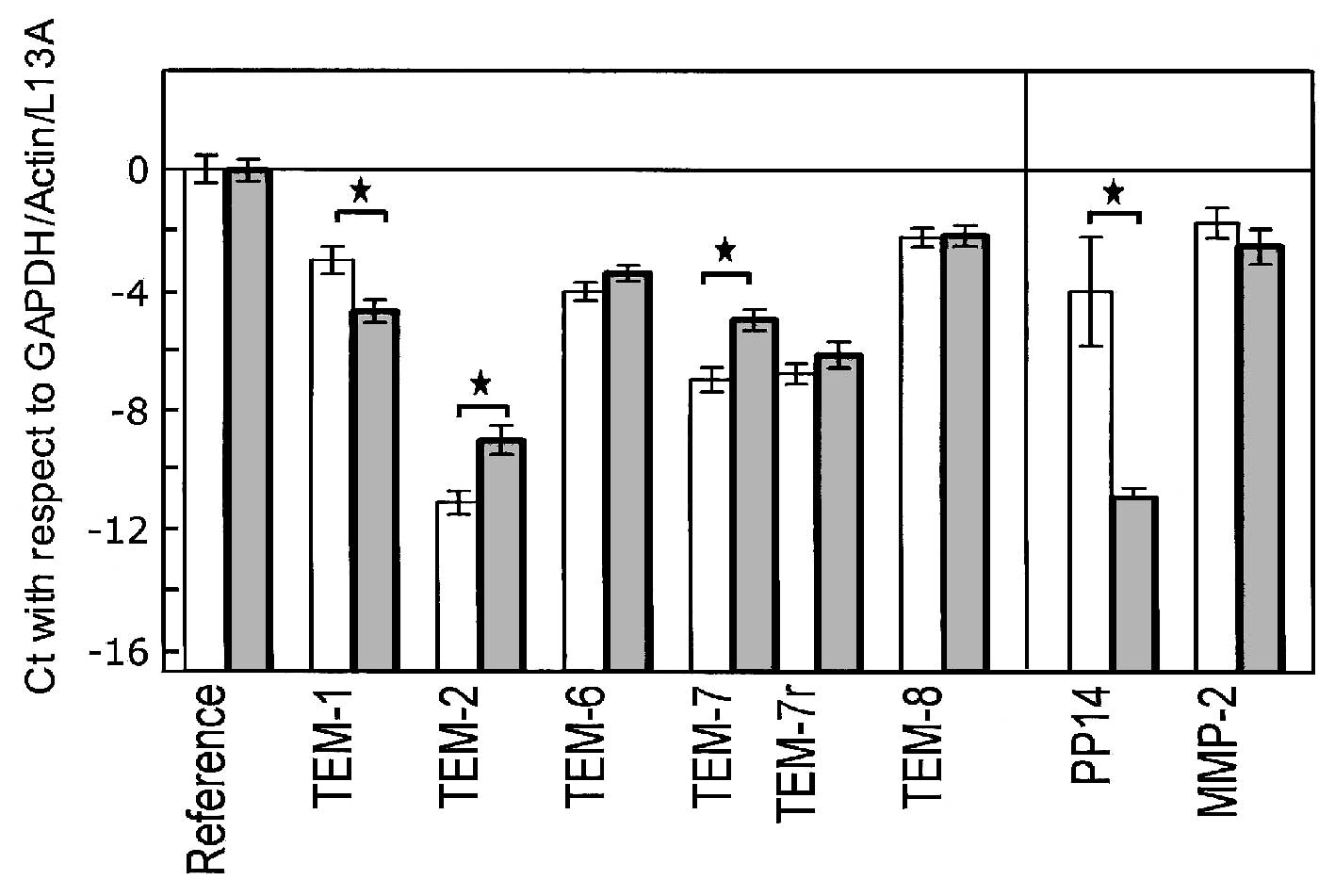|
1
|
Folkman J: Tumor angiogenesis: Therapeutic
implications. N Engl J Med. 285:1182–1186. 1971. View Article : Google Scholar : PubMed/NCBI
|
|
2
|
St Croix B, Rago C, Velculescu V, et al:
Genes expressed in human tumor endothelium. Science. 289:1197–1201.
2000.PubMed/NCBI
|
|
3
|
Carson-Walter EB, Watkins DN, Nanda A,
Vogelstein B, Kinzler KW and St Croix B: Cell surface tumour
endothelial markers are conserved in mice and humans. Cancer Res.
61:6649–6655. 2001.PubMed/NCBI
|
|
4
|
Nanda A and St Croix B: Tumour endothelial
markers: new targets for cancer therapy. Curr Opin Oncol. 16:44–49.
2004. View Article : Google Scholar : PubMed/NCBI
|
|
5
|
Rmali KA, Puntis MC and Jiang WG:
Prognostic values of tumor endothelial markers in patients with
colorectal cancer. World J Gastroenterol. 11:1283–1286. 2005.
View Article : Google Scholar : PubMed/NCBI
|
|
6
|
Davies G, Rmali KA, Watkins G, Mansel RE,
Mason MD and Jiang WG: Elevated levels of tumour endothelial
marker-8 in human breast cancer and its clinical significance. Int
J Oncol. 29:1311–1317. 2006.PubMed/NCBI
|
|
7
|
Leibovitz A, Stinson JC, McCombs WB, McCoy
CE, Mazur KC and Mabry ND: Classification of human colorectal
adenocarcinoma cell lines. Cancer Res. 36:4562–4569.
1976.PubMed/NCBI
|
|
8
|
Fogh J: Submission of Caco-2 cell line to
the American Type Culture Collection (ATCC). J Natl Cancer Inst.
58:221–226. 1977.
|
|
9
|
Dexter DL, Barbosa JA and Calabresi P:
N,N-dimethylformamide-induced alteration of cell culture
characteristics and loss of tumorigenicity in cultured human colon
carcinoma cells. Cancer Res. 39:1020–1025. 1979.
|
|
10
|
Davies G, Cunnick GH, Mansel RE, Mason MD
and Jiang WG: Levels of expression of endothelial markers specific
to tumour-associated endothelial cells and their correlation with
prognosis in patients with breast cancer. Clin Exp Metastasis.
21:31–37. 2004. View Article : Google Scholar
|
|
11
|
Rmali KA, Watkins G, Harrison G, Parr C,
Puntis MCA and Jiang WG: Tumour endothelial marker 8 (TEM-8) in
human colon cancer and its association with tumour progression. Eur
J Surg Oncol. 30:948–953. 2004. View Article : Google Scholar : PubMed/NCBI
|
|
12
|
Mandelin E, Lassus H, Seppala M, et al:
Glycodelin in ovarian serous carcinoma: association with
differentiation and survival. Cancer Res. 63:6258–6264.
2003.PubMed/NCBI
|
|
13
|
Koistinen H, Seppala M, Nagy B, Tapper J,
Knuutila S and Koistinen R: Glycodelin reduces carcinoma-associated
gene expression in endometrial adenocarcinoma cells. Am J Obstet
Gynecol. 193:1955–1960. 2005. View Article : Google Scholar : PubMed/NCBI
|
|
14
|
Bogusiewicz M, Stryjecka M and Rechberger
T: Activity of matrix metalloproteinases -2 and -9 (MMP-2 and
MMP-9) and content of their tissue inhibitors in endometrial cancer
- a preliminary study. Ginekol Pol. 78:366–372. 2007.PubMed/NCBI
|
|
15
|
Shaco-Levy R, Sharabi S, Benharroch D,
Piura B and Sion-Vardy N: Matrix metalloproteinases -2 and -9,
E-cadherin and beta-catenin expression in endometriosis, low-grade
endometrial carcinoma and non-neoplastic eutopic endometrium. Eur J
Obstet Gynecol Reprod Biol. 139:226–232. 2008. View Article : Google Scholar
|
|
16
|
Rmali KA, Al-Rawi MA, Parr C, Puntis MC
and Jiang WG: Up-regulation of tumour endothelial marker-8 by
interleukin-1β and its impact in IL-1β induced angiogenesis. Int J
Mol Med. 14:75–80. 2004.PubMed/NCBI
|
|
17
|
Folkman J, Merler E, Abernathy C and
Williams G: Isolation of a tumor factor responsible for
angiogenesis. J Exp Med. 133:275–288. 1971. View Article : Google Scholar : PubMed/NCBI
|
|
18
|
Papetti M and Herman IM: Mechanisms of
normal and tumour-derived angiogenesis. Am J Physiol Cell Physiol.
282:947–970. 2002. View Article : Google Scholar
|
|
19
|
Folkman J and Klagsbrun M: Angiogenic
factors. Science. 235:442–447. 1987. View Article : Google Scholar
|
|
20
|
Reynolds L, Killilea SD and Redmer DA:
Angiogenesis in the female reproductive system. FASEB J. 6:886–892.
1992.PubMed/NCBI
|
|
21
|
Reynolds L and Redmer DA: Expression of
the angiogenic factors, basic fibroblast growth factor and vascular
endothelial growth factor in the ovary. J Anim Sci. 76:1671–1681.
1998.PubMed/NCBI
|
|
22
|
Gargett CE and Rogers PA: Human
endometrial angiogenesis. Reproduction. 121:181–186. 2001.
View Article : Google Scholar
|
|
23
|
Krikun G, Schatz F and Lockwood CJ:
Endometrial angiogenesis: from physiology to pathology. Ann NY Acad
Sci. 1034:27–35. 2004. View Article : Google Scholar : PubMed/NCBI
|
|
24
|
Hervé MA, Meduri G, Petit FG, Domet TS,
Lazennec G, Mourah S and Perrot M: Regulation of the vascular
endothelial growth factor (VEGF) receptor Flk-1/KDR by estradiol
through VEGF in uterus. J Endol. 188:91–99. 2006.PubMed/NCBI
|















